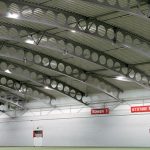Brace your structure: The purpose of steel bracing
Steel bracing runs between larger girders of a construction. Depending on the construction itself, these pieces of steel bracing may run at angles from one girder to another and then back again (giving an almost zigzag appearance), while other steel bracing installations may utilize both horizontal and angled braces connecting with the girders. Steel girders can hold tremendous amounts of weight, which is why steel is one of the most utilized building materials, especially when it comes to multi-level constructions.
With the strength and durability of the steel girders, one might wonder what the purpose of a bracing system in steel structure buildings is for. It’s all about providing necessary structural support. Here is what you need to know about the purpose of bracing steel beams in any building.
The General Purpose of Bracing Steel Beams
Steel girders can hold up an incredible amount of weight. However, this weight is all vertical. It doesn’t protect against horizontal shifts that might affect the building. Due to this, the bracing steel beams are designed to provide additional protection, bracing, and resistance against horizontal traveling loads.
What Might Affect A Building Horizontally
Buildings are tested to be able to withstand weight applied on top of the construction. It is the horizontal force applied to a building, though, that can often see the greatest variables. Strong wind, for example, is one of the most common forms of horizontal force applied to a building. The taller the building, the more it is exposed to wind, which means the sheer force of the wind increases. The additional pressure applied to the side of the building can cause the metal girders to begin to sway and bend. With enough pressure, the building may eventually sustain structural damage or even collapse. The sustained damage may not happen all at once but instead, occur over time.
The additional steel bracing moving between the steel girders helps protect against this horizontal force applied to the building. Because the girders are not isolated and standing on their own but instead interconnected with the other girders, it helps absorb the force applied by the wind and distribute it throughout the rest of the building. This way, instead of only the girders on the wind-absorbing side experiencing the pressure of the horizontal force, the force is evenly distributed to all other girders, which in turn dramatically reduces any chance of structural damage.
When the building braces against the wind, the building can send the energy down into the foundation of the building (some extremely tall buildings have extremely deep footprints not only to anchor the construction but to give additional leeway for transmitting the energy).
Protects Against Other Forms Of Horizontal Force
The wind is the most common form of horizontal force a building will sustain. However, it is not the only form it might come in contact with. Earthquake, for example, is one of the most damaging. The sudden shift can send a far stronger push against the building. While only certain areas of the world need to plan specifically for this kind of situation (such as California in the United States), earthquakes happen in just about any other part of the country, just not as severe or as often.
Even though an earthquake may not happen as frequently as in California, it is still important to plan for such a natural event. The bracing system will help distribute the weight shift in the event of an earthquake, preventing, or at the very least limiting, damage to the building.
Support Within The Building
Not all structural damage is sustained due to natural events. The point at which a runway girder and a building column come in contact is one of the more common areas of failure within a building. An internal crane surge can lead to structural damage that may go unnoticed. There are various ways construction can help limit or reduce this kind of sustained damage, and steel bracing is one such viable option. This way, the installed steel bracing can not only help protect against wind and earthquakes, but it can help protect against structural issues a building might sustain on its own.
Varying Forms Of Steel Bracing
There are different kinds of bracing steel beams used in construction. Those mentioned above are used to protect against wind and horizontal forces and reduce the chance of the building toppling over. Diagonal bracing (or, in some cases, lateral bracing) is used to help prevent the building from twisting. Twisting is most commonly caused by severe wind. Wind does not always strike a building head-on. Instead, it may hit the building at an angle, which means it is more likely to twist along with the wind.
Typically, structural engineers and the architect will not only work on the building itself to determine what kind of steel bracing support it needs but the placement of the building will also be studied to see if additional support is required based on active natural elements.
Steel Bracing For Your Building Design
The structural architect of any building will understand not only how much weight the building material can hold but also if it needs to utilize the structural support of steel bracing. When exposed to natural elements like wind or earthquakes, a building will rock and shift. The taller a building, the greater the chance of this happening, so steel bracing becomes that much more critical for not only building integrity but for human safety. If you’re looking at steel bracing options, C-Beams has you covered.
Whether you are only in need of steel bracing material or looking for various beam options, C-Beams will work with you to identify the right materials for your construction project. Customer service specialists are on hand to assist you and address all of your concerns, so give C-Beams a call or send out an email at your earliest convenience.






